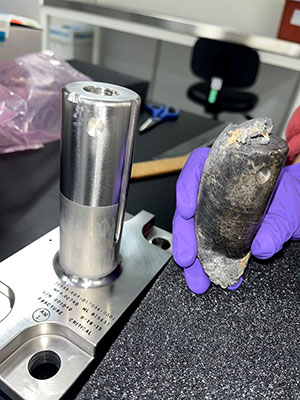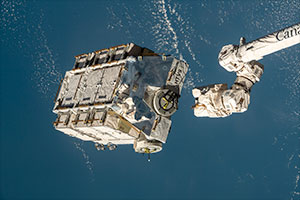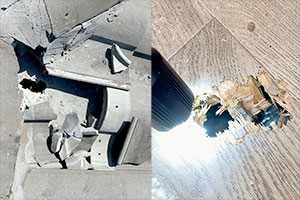April 15, 2024 — A chunk of metal that tore through a Florida home last month has been confirmed by NASA to have fallen from the International Space Station.
The previously unknown space object, which looks to have been partially melted and mangled, has been identified by space agency scientists as the remnants of a stanchion used to mount nickel hydride batteries on a cargo pallet after they were replaced by more capable lithium-ion units. Flight controllers then used the space station's robotic arm to jettison the pallet in March 2021, with the intention that it and its contents would burn up when they plunged back into Earth's atmosphere.
Instead, at least one 4-inch-long by 1.6-inch-wide (10-by-4 centimeter) fragment survived reentry and crashed through the roof and two floors of Alejandro Otero's home in Naples.
"Almost hit my son," Otero wrote on X (formerly X) while sharing photographs of the piece and the damage it caused to his house on March 15.
Following the advice he received in response to his post, Otero contacted NASA, which collected the debris for inspection at the Kennedy Space Center in Florida.
"NASA completed an assessment of the object's dimensions and features compared to the released hardware and performed a materials analysis," wrote Mark Garcia, a social media consultant working in support of NASA, on the agency's website. "Based on the examination, the agency determined the debris to be a stanchion from the NASA flight support equipment used to mount the batteries on the cargo pallet."
Originally, NASA had planned to dispose of the pallet in a more controlled manner, but delays to the battery upgrades resulted in the pallet having to be jettisoned. Even then, It was not expected that any parts would survive, or it any did, that they would fall over a populated area.
"The International Space Station [program] will perform a detailed investigation of the jettison and re-entry analysis to determine the cause of the debris survival and to update modeling and analysis, as needed," wrote Garcia.
"NASA specialists use engineering models to estimate how objects heat up and break apart during atmospheric reentry. These models require detailed input parameters and are regularly updated when debris is found to have survived atmospheric reentry to the ground," he wrote.
The 1.6-pound (725-gram) piece of Inconel metal alloy debris was a very small fraction of the approximate 5,800 pounds (2,630 kilograms) of material that comprised the pallet and batteries. It was and still is the most massive item thrown overboard from the International Space Station in its more than 25 years circling the planet.
Although more common from the Russian segment of the space station, most spent hardware and debris is not left to fall back to Earth itself. Visiting vehicles, such as the U.S. Dragon and Cygnus commercial cargo spacecraft, as well as Russia's Progress capsules are routinely used to dispose of the station's refuse.
Under the provisions of the Outer Space Treaty of 1967, party nations are liable for any damage their spacecraft may cause. It is not known if Otero requested and/or received compensation for the holes left in his house by the falling NASA stanchion.
The treaty also stipulates that all spacecraft debris, regardless of where it may be found, on or off Earth, remains the property of the sponsoring nation until explicitly relinquished.
"NASA will be responsible for the item until a determination is made on what to do with the object," a NASA spokesperson told collectSPACE on Monday (April 15).
Going forward, the space agency remains "committed to responsibly operating in low Earth orbit," Garcia wrote, "and mitigating as much risk as possible to protect people on Earth when space hardware must be released." |
|

Recovered stanchion (at right) compared with a unused unit like the type used to mount International Space Station batteries on a cargo pallet and which fell back to Earth on March 8, 2024. (NASA)

An external pallet packed with degraded nickel-hydrogen batteries is released from the International Space Station by the Canadarm2 robotic arm on March 11, 2021. (NASA)

Damage to Alejandro Otero's Florida home after being hit by debris from the International Space Station. (Alejandro Otero via X) |
